Why did Olav Lundanes win the race, what were the decisive moments in the race, and what were the best choices on all the interesting routechoice legs the Men’s WOC 2017 Long distance course had to offer? This article attempts to answer these questions based on detailed analysis of GPS-data and official split times.
The WOC 2017 Men’s Long distance course offered three long routechoice legs in addition to several medium long legs. The athletes spread out onto a large number of different routes on these longer legs, for some of the legs like the 2nd leg shown below it was nearly as if there was one route per athlete – as if the athletes searched everywhere for some small pieces of Estonian forest where you could run and get flow instead of just fight. Those of you who have been in these types of Estonian forest at summer time know that there is no such place – all of the forest is green with lots of fallen branches, and generally the forest which is marked white on the map can be slower to get through than forest which is marked light green or even medium green in other terrain types.
This short video clip shows around 20 seconds from the course which is in a light green area – this is typical for light green on this map.
The fact that runnability varies a lot for a given type of map symbol – especially for the marshes – makes it even more tricky to take the right route choices in this terrain. As a runner you have to use all the experience you have from this terrain type to try to understand the runnability from the map – and then adapt to the terrain as you move through it. This is part of the reason why Olav Lundanes has been training between 50 and 70 trainings in Estonian terrain in his preparations for the World Championships.
The fact that runnability varies a lot for a given type of map symbol – especially for the marshes – makes it even more tricky to take the right route choices in this terrain.
This article is divided into two parts;
- Part 1: Route choice analysis leg by leg: What is the best choice on each leg in the course
- Part 2: Race analysis: What were the decisive moments in the race
Due to the big spread on different routes and lots of micro routechoices, it is tricky to make an analysis with clear answers, but it is still attempted below.
You find the complete map and GPS tracking her:
WOC Long Men

» See map in omaps.worldofo.com
Part 1: Route choice analysis leg by leg
Introduction
After working through the analysis, the overall conclusion is that the biggest difference between the runners on this course was their ability to take the right micro routechoices along with execution of the chosen route – this is especially important in the southern part of the terrain (until around control 13, here the course/terrain changes characteristics). There are typically several routes which are nearly equivalent time wise if the right micro routechoices are taken and the route is well executed.
If you look into the details and compare the ones who seem to have really understood how to orienteer in this terrain (for example Lundanes and Novikov) with the others, there are numerous small differences where the ones skilled in this terrain consistently earn time on the others. Places where Novikov earns time on many others are often characterized by being shorter and providing the same or better runnability. You need to know the terrain type well to make good choices – and you need to execute well to run the shortes way through the terrain. Here are some examples:
Aigars provides some nice thoughts about how to choose your route in this type of terrain in the comment, especially with respect to the micro routechoices.
Leg 2
After a short leg to the first control, the first real challenge came on the 2.5 kilometer long leg to the second control. Looking at the routes chosen by the runners, they go basically everywhere. Around 30-35 different routes are chosen, spreading out to a fan 750 meters to each side of the line between the control (see video on the top of this article).
The below illustration shows the fastest runner on each main variant, where 10 different main variants are identified. For many of the main variants there are several micro routechoices on the way.
It is easier to understand how fast the different variant are by grouping the routes into variants and given each variant a separate color, allowing for a certain amount of micro-routechoices with each variant:
Lundanes and Novikov are fastest on the straight (blue) variant, half a minute faster than Regborn who is fastest on the variant to the left on the road, with Hubmann and Sild on nearly the same time. However, if we exclude Lundanes and Novikov from the analysis as they were in a separate class physically throughout the competition, direct (blue) and left (red) seems quite equivalent time-wise. This is an example in agreement with what is written in the introduction; there are typically several routes which are nearly equivalent time wise if the right micro routechoices are taken and the route is well executed.
Note that going left has lower risk, and that runners on a lower level can execute it well. 2 km of the 3.5 km route choice for the 2.5 km leg is on road (run with speed around 3:30 min/km for Regborn & co), another 600 meters is on good path, the rest in mostly white forest. It may, however, not be so tempting for the runners to choose this route because you have to run back through the start. This may be the reason why relatively few chose this route. Hubmann, & Co run around 3:30 on the road for these 2.5 km.
Going right (green) is significantly slower. This may be partly due to which runners chose to go right, but compared to going left the length of the leg is approximately equal, but there is 15 meter more climb and the runnability in the forest seems more variable.
Update: Kyburz (who stopped the race and therefore was not in the official split times) ran right in a time about one minute slower than Lundanes/Novikov. Thus although he looses a minute, this is also a valid alternative.
Conclusion: Left and direct quite equal, but for most runners left would probably be the best choice due to lower risk.
Leg 4
Another long leg to control 4. Again the challenge is to exploit all the good runnable areas you can find (especially roads and paths), while still keeping the length and climb to a minimum. For the first half of the leg the task is to get to the big path around the open areas as fast as possible. For the second half of the leg you can choose either to go straight, to use the road to the right, or the path and open areas to the left.
Looking at the routes run, there is yet again a lot of spreading onto different routechoice:
Again Olav Lundanes and Leonid Novikov are in a separate class – there is one minute down from Lundanes/Novikov to the next runner Fabian Hertner (note that William Lind is closer, but he has been caught by Lundanes and thus profits from Lundanes’ speed and orienteering).
Lundanes and Novikov choose approximately the same route for the first half of the leg, but for the second part they go different ways. Novikov goes right, Lundanes goes left. These two options seem to be fairly equivalent based on the split times. By coloring each variant with a specific color it is easier to see that red/blue is approximately equivalent.
Conclusion: Again there are several routes which are nearly equivalent time wise if the right micro routechoices are taken and the route is well executed.
Update: Based on a comment below by “Swiss”, I took a look at Kyburz’ route (Kyburz had to give up the race due to loosing a contact lens plus the spare contact lens), and he has taken his own routechoice to the left with a time which corresponds to the third best time on this leg:
Update 2 (from course setter): Tue Lassen’s choice from right to left is equal to Lundanes choice. When comparing from power line in the middle of the leg, Kyburz is 12 sec faster than Lundanes to the control. However, this 12 sec is exactly what it takes to run from Lundanes route to Kyburz route, i.e. it is the first part of Kyburz’s route which is slower.
Leg 8
To leg number 8 is there again the choice of using the road to the left to get more road running and less risk, or of running more direct and shorter.
Below you see the best routes on this leg, colored by chosen route. You can see that the best times are ran by athletes who run direct. Running left on the road does again give lower risk (as there are fewer places to make errors), but is slightly longer. The Swiss runners Daniel Hubmann and Fabian Hertner choose to run left – so does the fast sprint silver medalist Frederic Tranchand.
Leg 12
Leg 12 within the forking is more a type of middle distance leg (note that analysis in the forking is based on GPS-time and not Emitag-times). There is however an interesting routechoice here as well: Go direct and orienteer carefully and hope for good runnability in the white, or choose the path/field which makes the orienteering it easier.
It is quite clear from the GPS-data that using the path/field to the right reduces risk and is a better choice.
Leg 14
Leg 14 is interesting because a new element is introduced in the considerations: Climb. The previous legs had very little climb, but from control 13 and onwards there is a deep valley with marsh in the bottom which must be crossed several times.
The main choice on this leg is it one should go right and exploit the path, road and open areas or go more straight. Looking at the GPS, it looks like one of the keys here is to exploit the path on the way down to the valley.
Here are the best 6 split times on this leg (according to GPS-times):
Update (based on input from course planner): The following may or may not apply to the best runners. No runners managed to execute the leg perfectly via long run around on the right, which according to test running was the best choice. Exit control 13 as Bilic, continue leg as Pijak. In test runs we got about 2 min advantage for this route choice, so I would guess that even for Lundanes, it may be about 1 minute faster than going straight. The time gain comes from possibility to climb the valley on path.
Leg 16
Leg 16 has few areas along the straight line between the controls with so low runnability that it is necessary to consider a routechoice other than direct. However, the GPS-tracking shows that quite a few runners run far away from the straight line, thus running much extra. The pair Olav Lundanes/William Lind is fastest on the leg by running fairly straifght.
Leg 20
Leg 20 is the last long routechoice leg. Here again the contours/climb is an extra element when choosing your route, but on the other hand vegetation is less of an element as we are now in a nicer part of the forest (but white is still quite green after normal standards).
Surprisingly there is a lot of spreading along lots of different routes – a bit like the first control.
It is, however, quite interesting to look at just the three best on this leg. Here we see that Magne Dæhli wins the leg with 42 seconds, but the route he has chosen does not seem 100% optimal. Probably this is just an effect of Dæhli being very strong at this point in the race, and all these three alternatives are nearly equivalent.
Leg 22
The last route choice leg is leg 22, a leg where you just have to choose a routechoice and run (except you are probably very tired at this point in the course).
Looking at the GPS-it is clear that going left is significantly faster, you loose aaround a minute if you have to go left.
Leg 23
Leg 23 is there mostly for transport, but as you can see from the GPS below you can loose time here as well if you are tired.
Part 2: Race analysis – decisive moments in the race
Here we take a brief look at the decisive moments in the race, that is were the winners won and the others lost. Let us start to repeat the overall results, to see how far each runner was from a top result.
| 1. | Olav Lundanes | NOR | 105:25 | (+0:00) |
| 2. | Leonid Novikov | RUS | 107:15 | (+1:50) |
| 3. | William Lind | SWE | 107:38 | (+2:13) |
| 4. | Magne Daehli | NOR | 108:33 | (+3:08) |
| 5. | Eskil Kinneberg | NOR | 109:58 | (+4:33) |
| 6. | Daniel Hubmann | SUI | 110:24 | (+4:59) |
| 7. | Fabian Hertner | SUI | 111:28 | (+6:03) |
| 8. | Johan Runesson | SWE | 111:49 | (+6:24) |
| 9. | Martin Regborn | SWE | 112:44 | (+7:19) |
| 10. | Timo Sild | EST | 113:36 | (+8:11) |
| 11. | Fredric Portin | FIN | 115:51 | (+10:26) |
| 12. | Jan Sedivy | CZE | 116:33 | (+11:08) |
| 13. | Hakon Jarvis Westergard | NOR | 117:15 | (+11:50) |
| 14. | Gernot Kerschbaumer | AUT | 117:29 | (+12:04) |
| 15. | Vincent Coupat | FRA | 118:44 | (+13:19) |
Control 1
Already to the first control after 1:35 running we had quite big time differences – here we probably mostly see the time invested in deciding the route choice for the long leg. Runesson is fastest with 1:35, Lundanes uses 14 seconds more and Novikov even 27 seconds behind.
Men: S-1 (Legtimes)
|
Men: S-1 (Total times)
|
Control 2
Investing time to choose the correct route to control 2 was however very important, as many runners loose at lot of time here. The following table shows the time loss for each runner who finished in the Top 20 on control 2 (left) and the current standing at control 2 (right):
Men: 1-2 (Legtimes)
|
Men: 1-2 (Total times)
|
Here we see that William Lind looses 3:16 and is 3:31 behind at control 3 (soon to be caught by Lundanes). Lind is only 2:34 behind at the end of the race, so Lind looses more here than he is behind gold in the end! Note however that Lind runs with Lundanes for significant parts of the race, so the comparison is not entirely fair towards Lundanes.
Here is a comparison between Ludanes and Lind. The reason Lind looses time is mostly micro routechoices, not investing enough in accurately planning and execution the routes. Linds routes are consistently longer.
Note also that Sedivy and Street significant time here, nearly 2 minutes. Even Magne Dæhli (1:18) and Fabian Hertner (0:56) loose significant time – in the end Dæhli is less than a minute from a medal and only 3:24 behind Lundanes. Looking at where Dæhli looses time, this is mostly towards the end of the leg, and mostly due to micro routechoices. Dæhli runs longer than Lundanes, and seems to not be careful enough with the orienteering.
Eskil Kinneberg looses 2:17 here, approximately the same he is a behind the winner in the end. Kinneberg’s problem here is not the microroutechoices but instead Kinneberg took the wrong route:
Hubmann is still in the game – 40 seconds behind Lundanes.
Control 4
There are smaller time differences to control 4 than on the long leg tocontrol 2, but still four of the runner who finish in Top 10 do one minute of mistake or more, including Magne Dæhli, Fabiann Hertner.
Men: 3-4 (Legtimes)
|
Men: 3-4 (Total times)
|
Clearly Dæhli looses time all the way, but most time where the routes are different, and typically when Dæhli runs a little bit longer, typically due to not being careful enough with the compass.
At this point in the race we already have Lundanes in the lead ahead of Novikov. Lind is down in 14th place – already caught by Lundanes with 4 minutes, and now running together with Lundanes for many controls.
Kinneberg looses another 1:39 here – the reason again seems to be wrong routechoice on part of the leg:
Here also Hubmann starts loosing time – loosing 1:30 on this control. Most of it is due to bad route choice (last part, 55 seconds), but he also looses more time throughout the leg due to what seems to be running speed.
Control 8 (before forking)
The leg to control 8 is the third long leg. Here Lundanes looses 12 seconds to Novikov, and there is suddenly only 1 second between Lundanes and Novikov, with Lundanes still ahead. Again Magne Dæhli loses a minute, and Regborn loses 1:39. Kinneberg also looses 41 seconds.
Men: 7-8 (Legtimes)
|
Men: 7-8 (Total times)
|
Again Dæhli’s time loss is of the same type, seemingly not being careful enoug with the micro-routechoices.
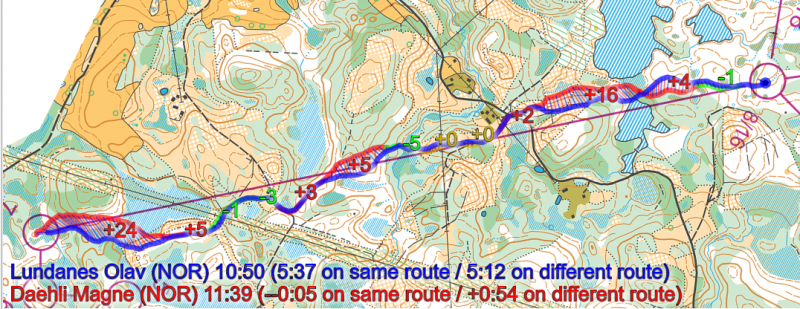
Control 18 (after forking)
Through the forking Novikov has lost 1:41 to Lundanes. Coming into the forking only 1 second behind, he is now 1:42 behind. Lind is still 4 minutes behind Lundanes, but as all the others have lost time, Lind is now up in third place.
Men: 17-18 (Legtimes)
|
Men: 17-18 (Total times)
|
Novikov makes two mistakes here, one to the 14th control and one to the 15th control, in total these two are around 1:10. In addition to these, Novikovd does some smaller mistakes and non-optimal routechoices.
Hubmann also does a few mistakes here, in total loosing more than 2 minutes to Lundanes – he is now suddenly 5:26 behind in 7th place, and never manages to get into the medal fight again. The biggest mistake is in the forking itself where Hubmann looses a minute, seemingly going to the wrong forking control (but he is alone here, maybe he follows track in the wet ground, there were some here).
Control 19
On the long leg to control 19 Magne Dæhli wakes up – as he always does towards the end of a long distance. Dæhli wins the leg with 42(!) seconds, even if the route does not seem fully optimal as seen from the map. Lundanes looses some time to Novikov here, but only 6 seconds for now.
Men: 19-20 (Legtimes)
|
Men: 19-20 (Total times)
|
Control 20
This is Olav Lundanes’ only mistake, and where William Lind gets away from Lundanes after having been together for an hour. Lundanes looses 57 seconds to William Lind here, but luckily for Lundanes, also Novikov looses time here (31 seconds), and thus the time difference between them does not grow so much.
Men: 20-21 (Legtimes)
|
Men: 20-21 (Total times)
|
Here is Lundanes’ mistake:
And here is what he told about it at the press conference: “- I know I wasn’t far away from the control, but you know, Estonian green. The control could be in any direction. I managed to stand still and read my way into the control. Maybe the mistake was bigger than it felt.”
There were no significant changes in the result in the rest of the race – “the spectator loop”.
Thanks for reading. Any comments for future analysis are welcome. Women’s analysis will come during Wednesday / Wednesday evening.
 World of O News
World of O News

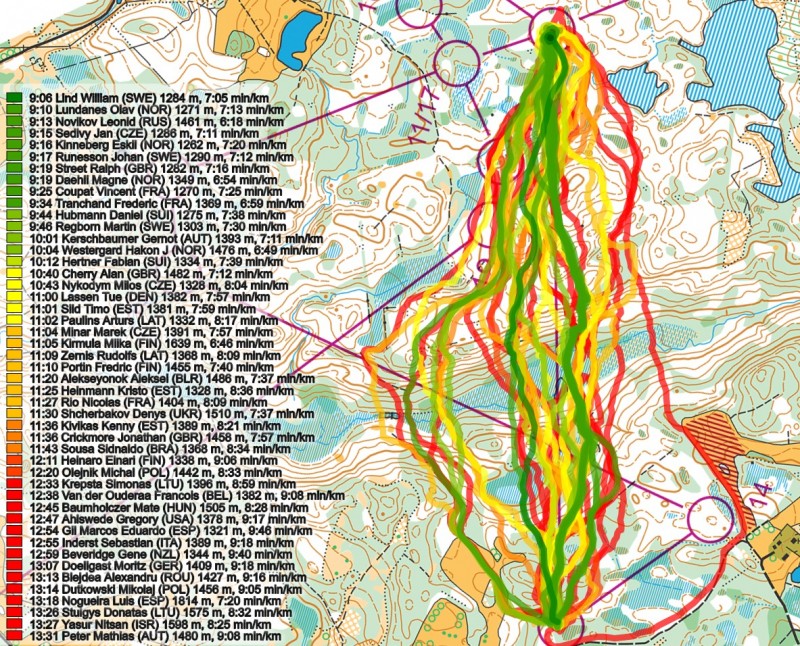
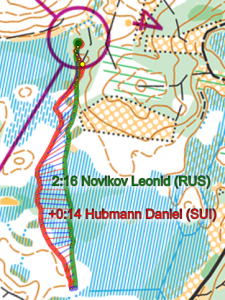
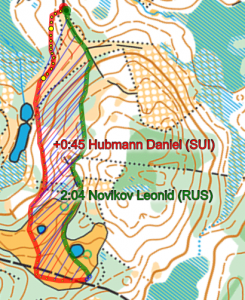

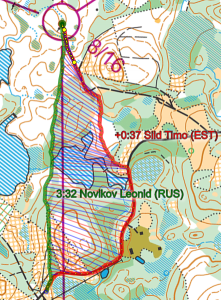

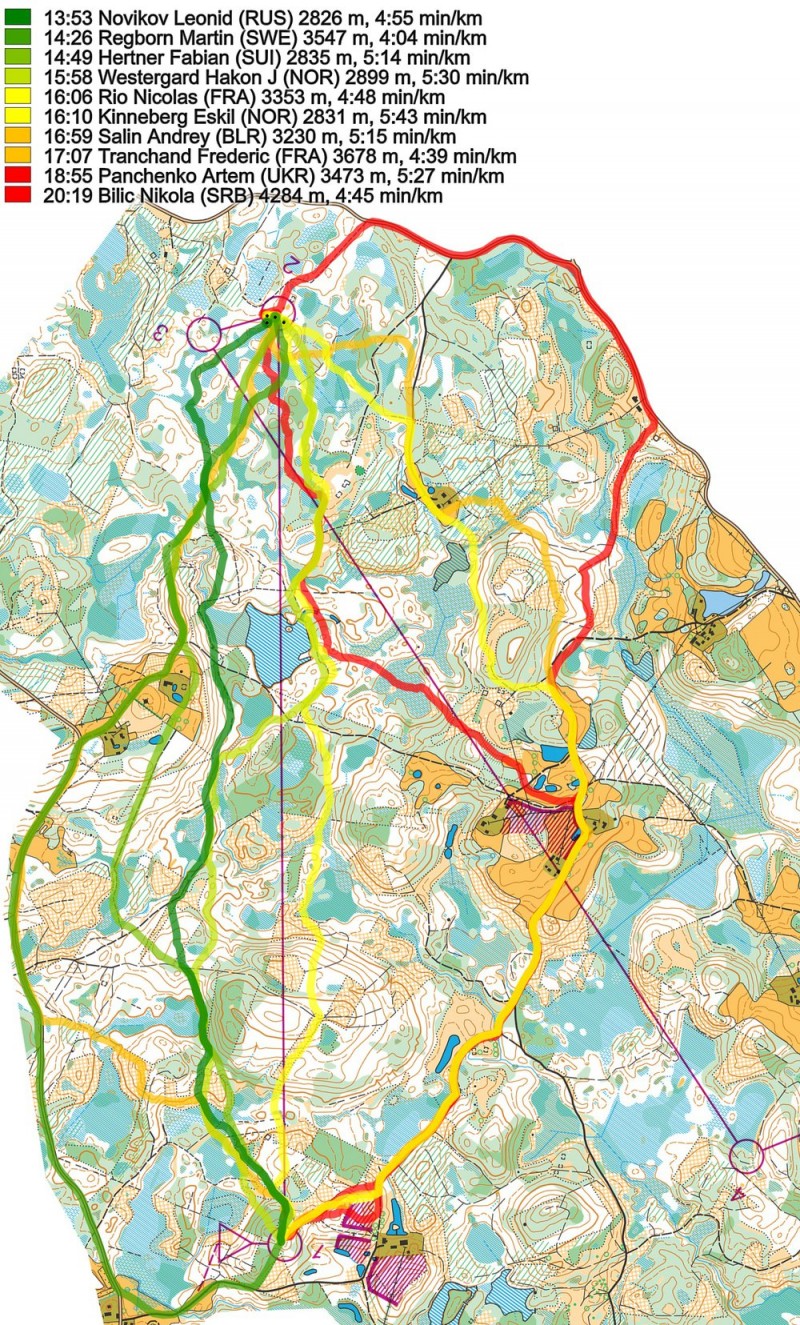
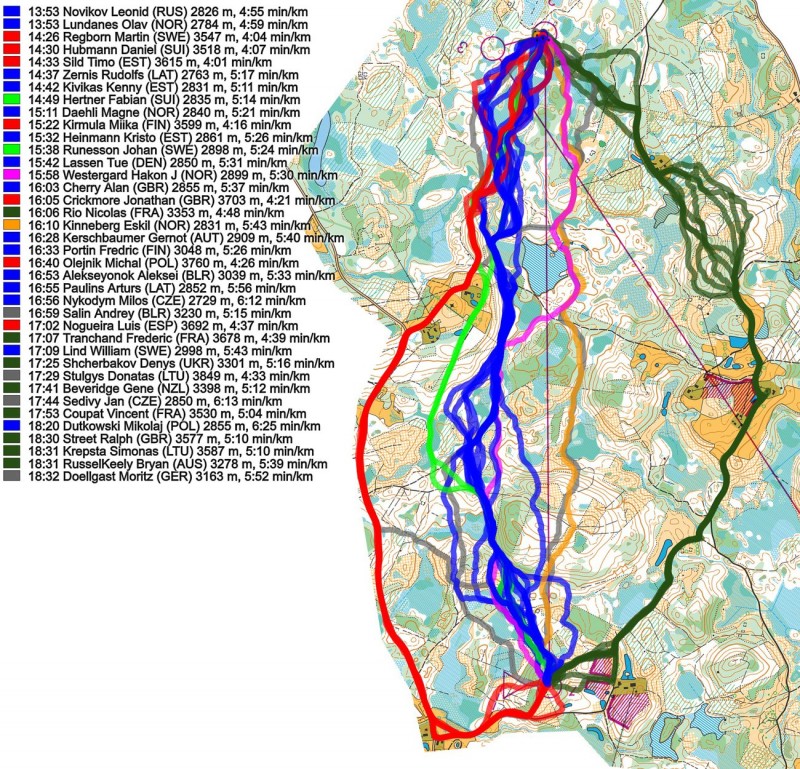
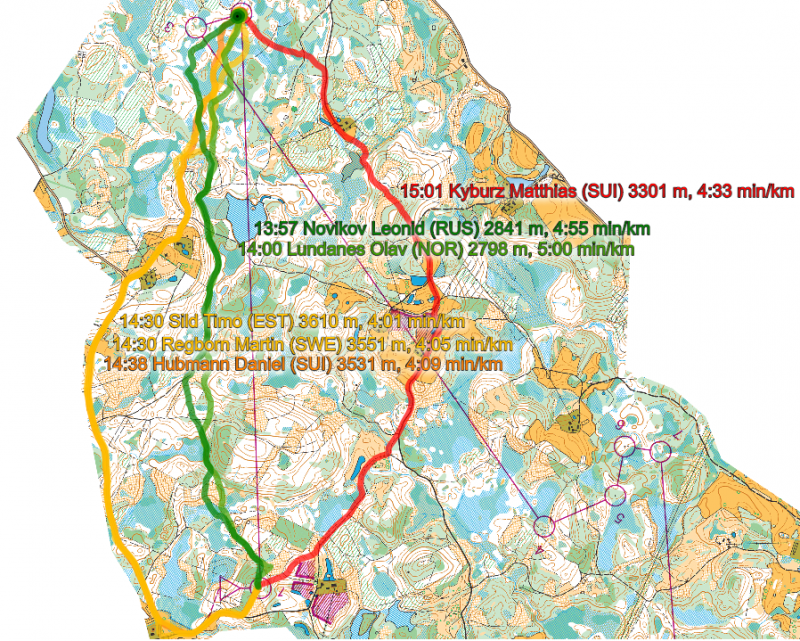
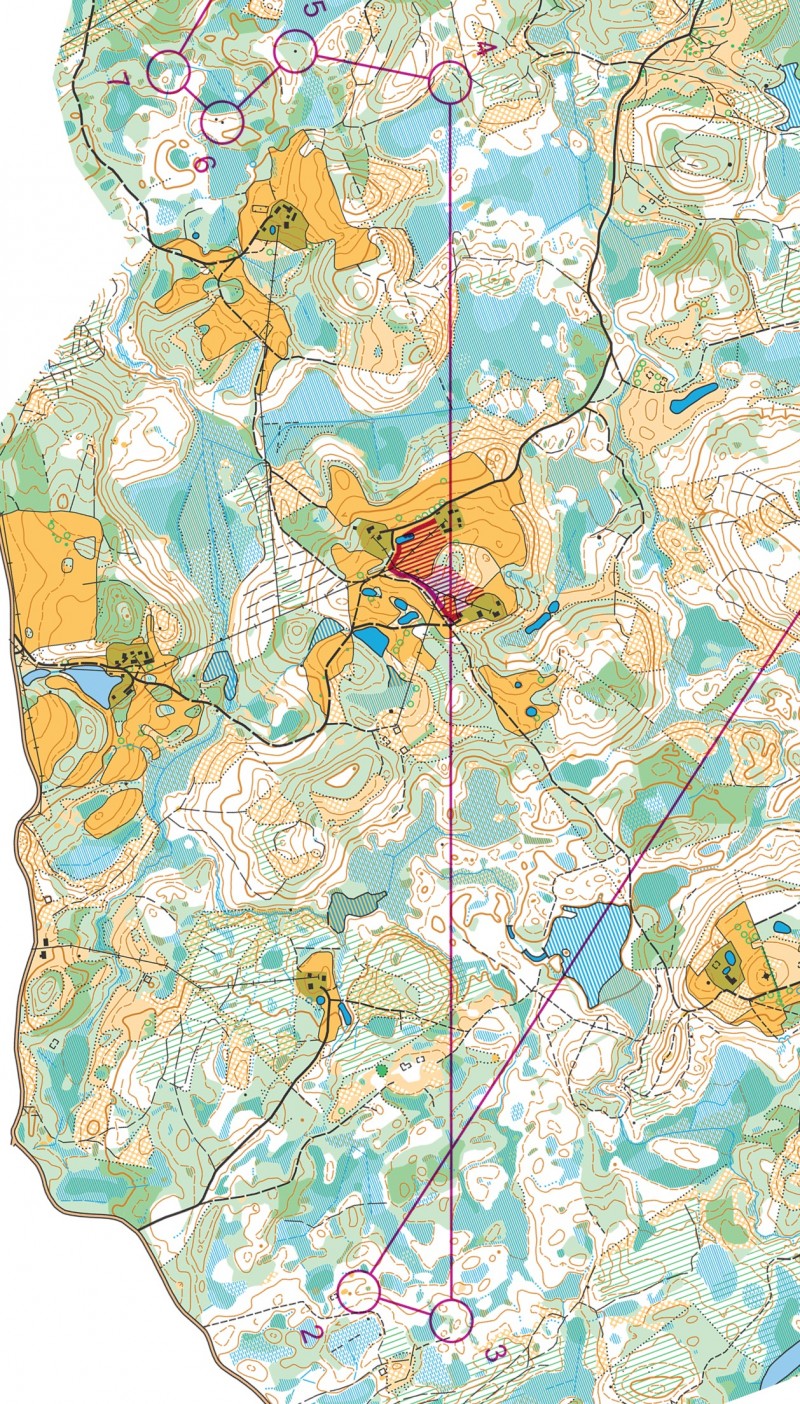
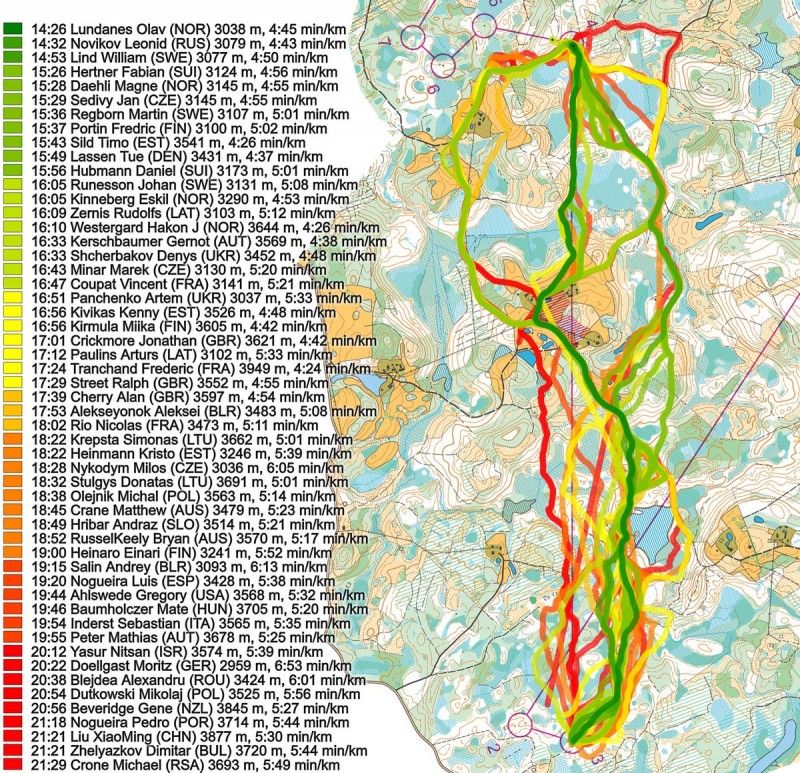

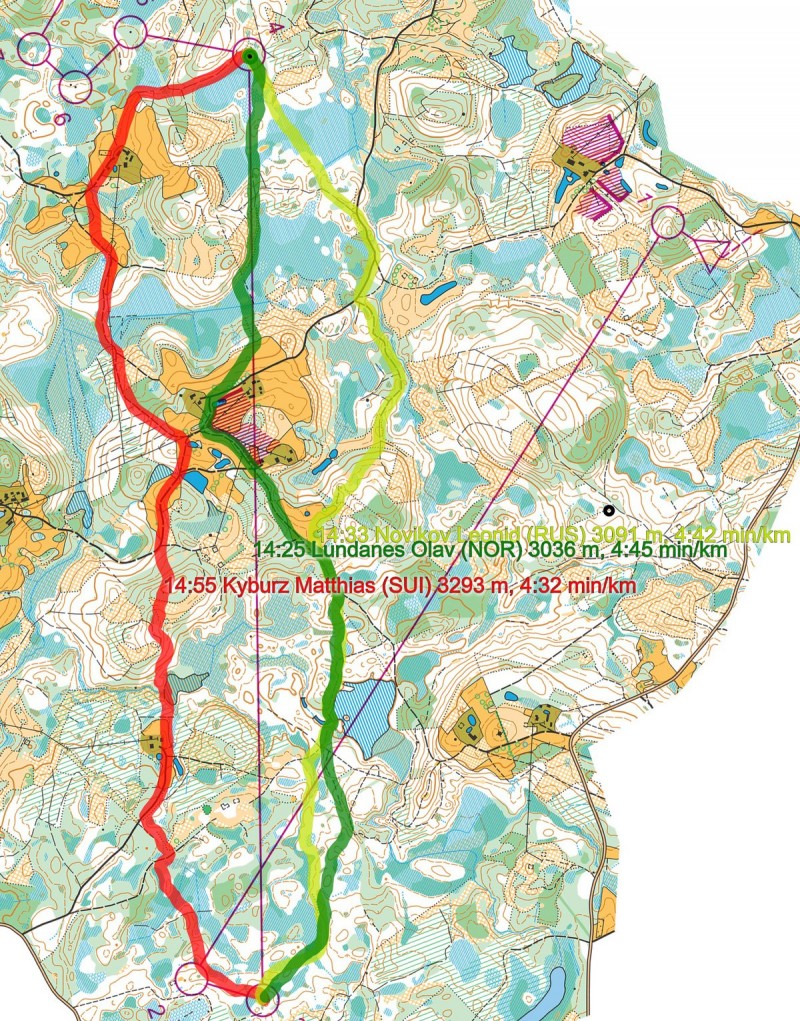
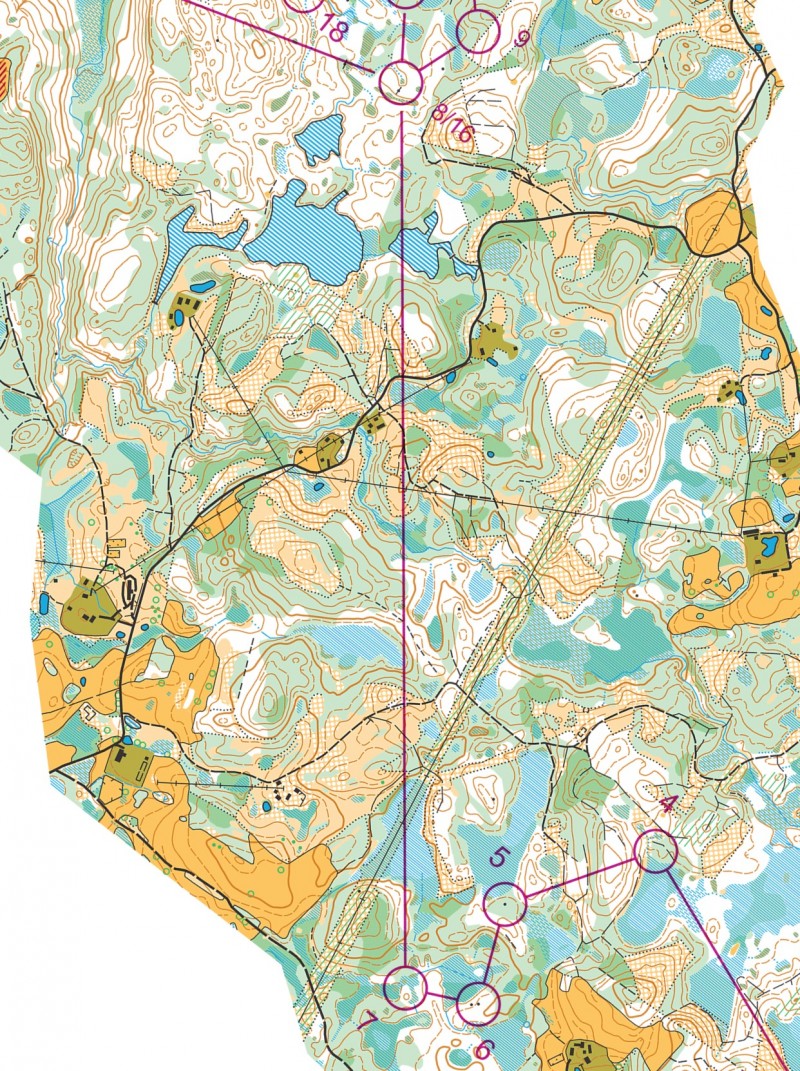


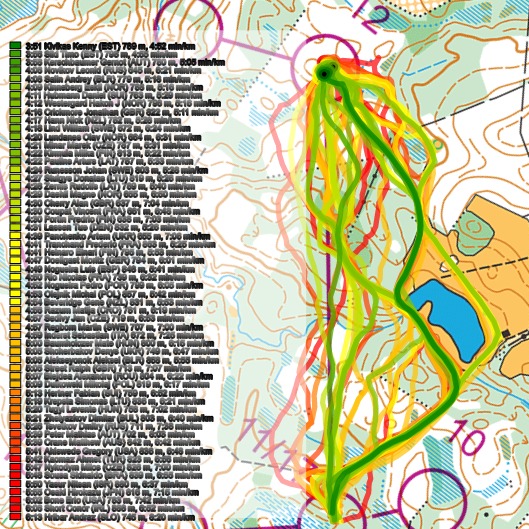
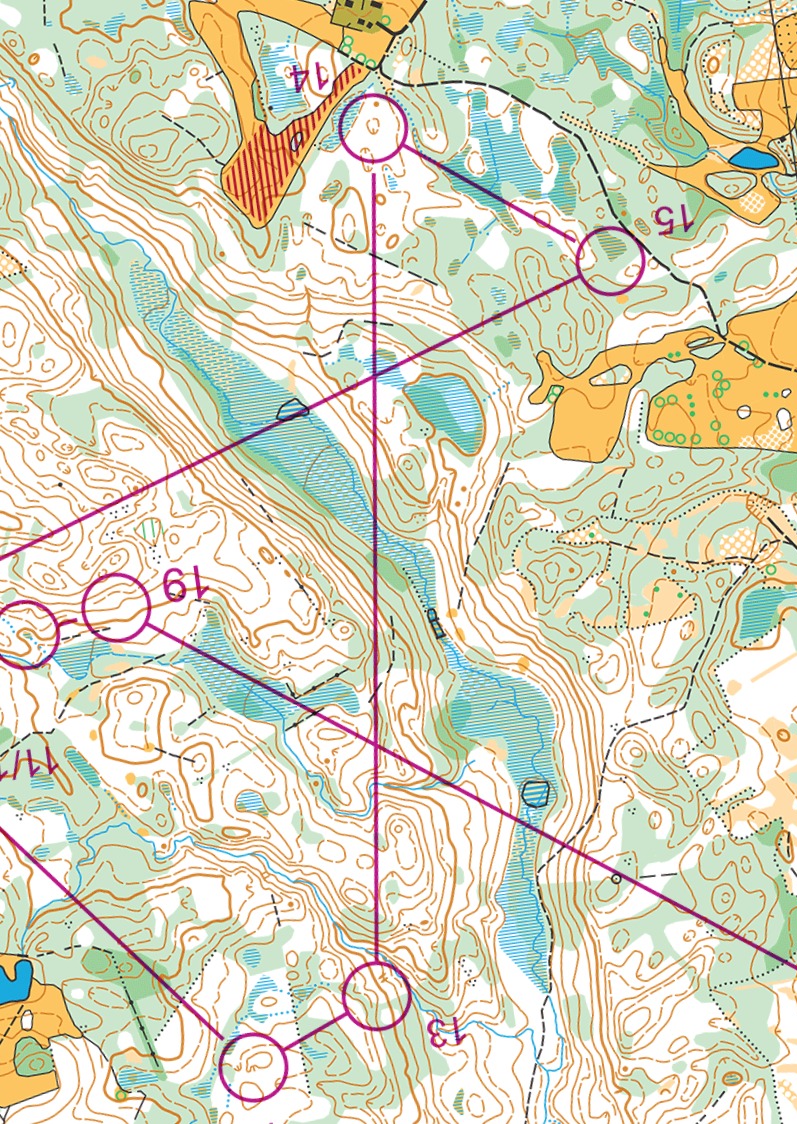
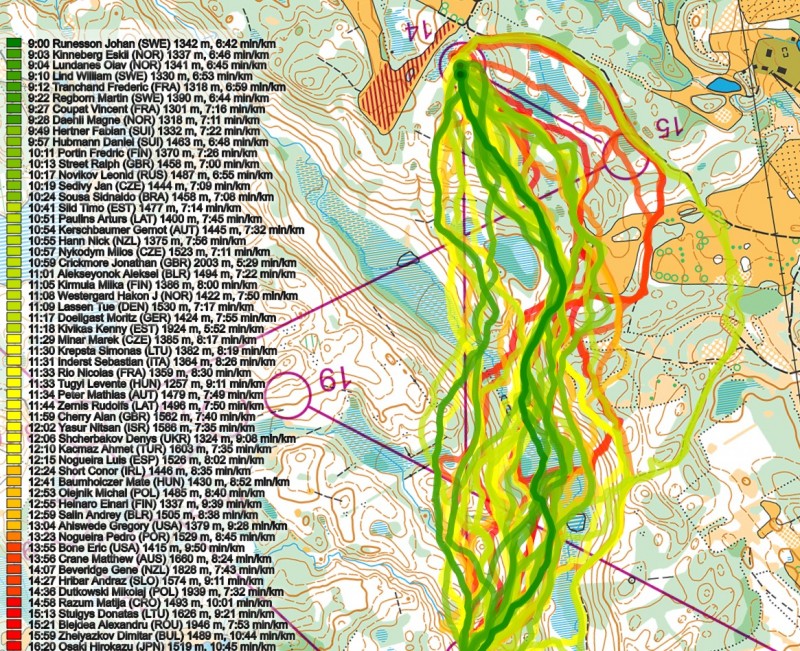

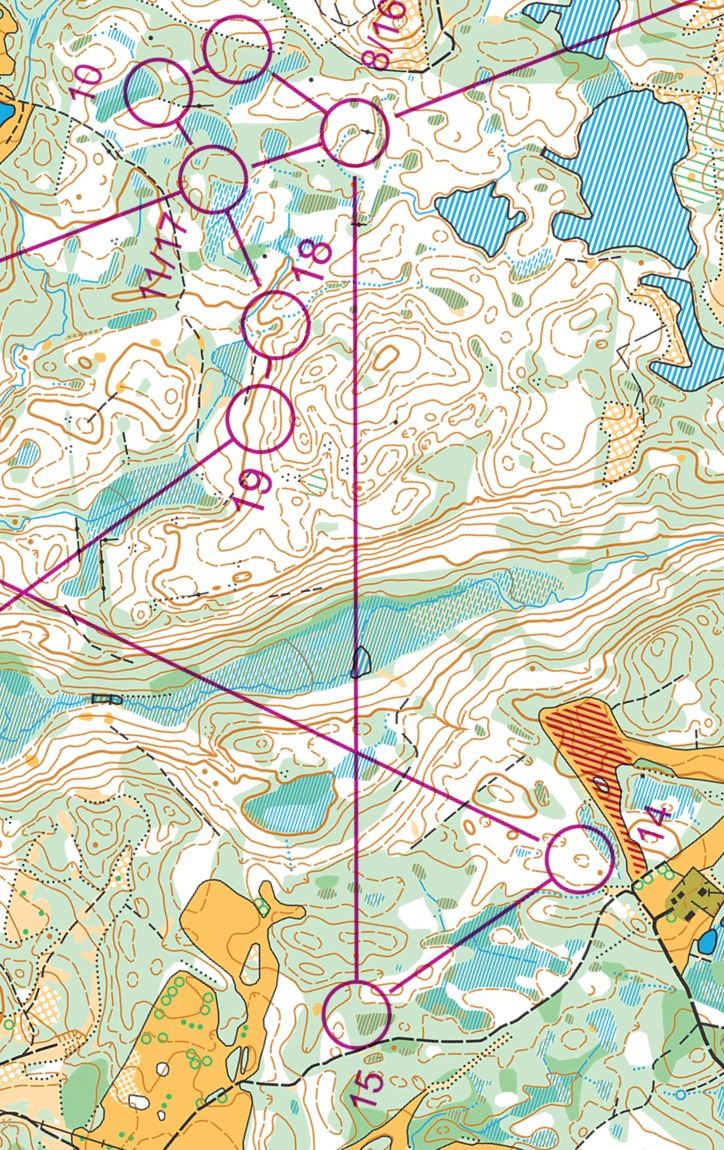
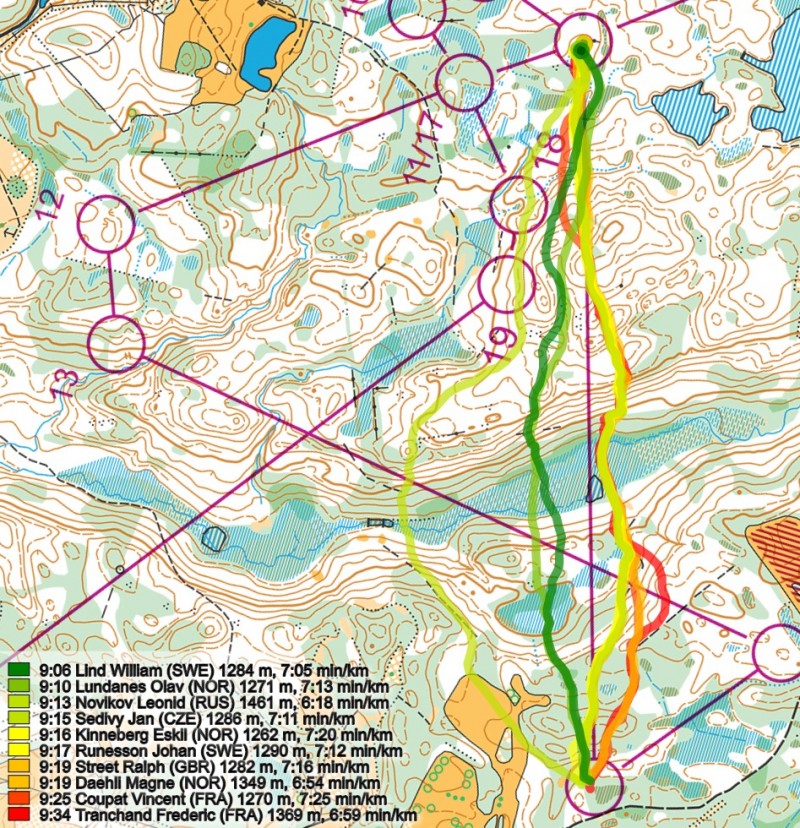

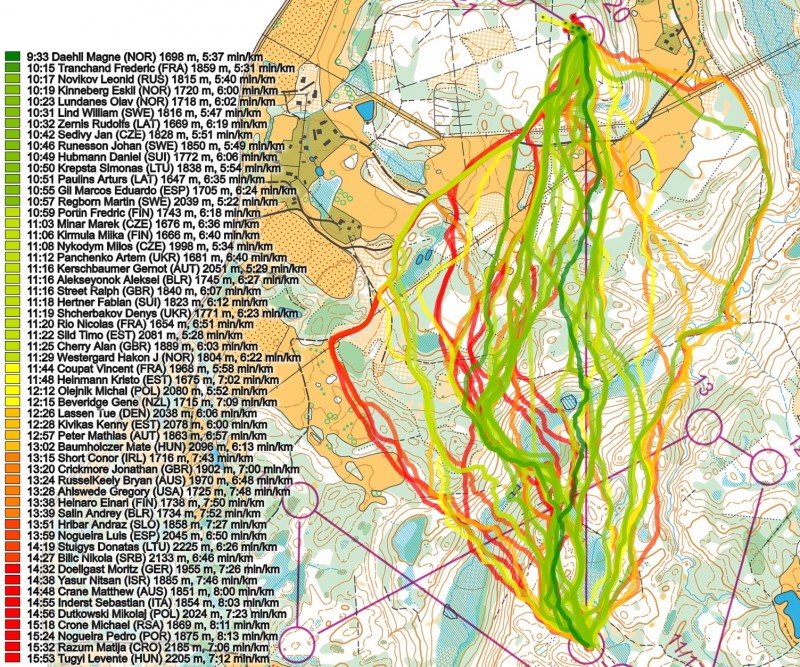
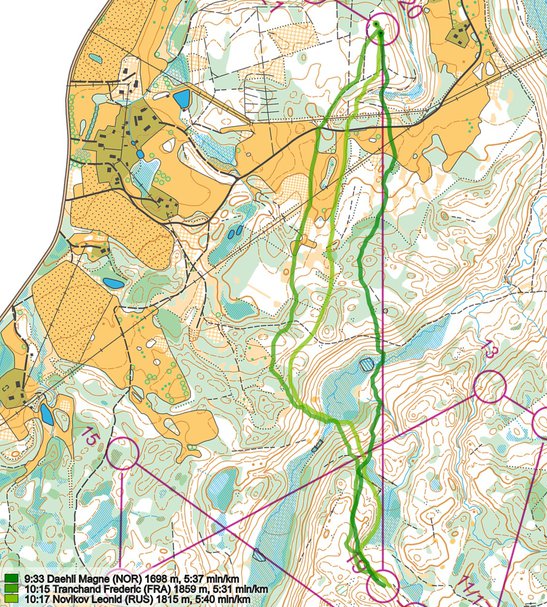
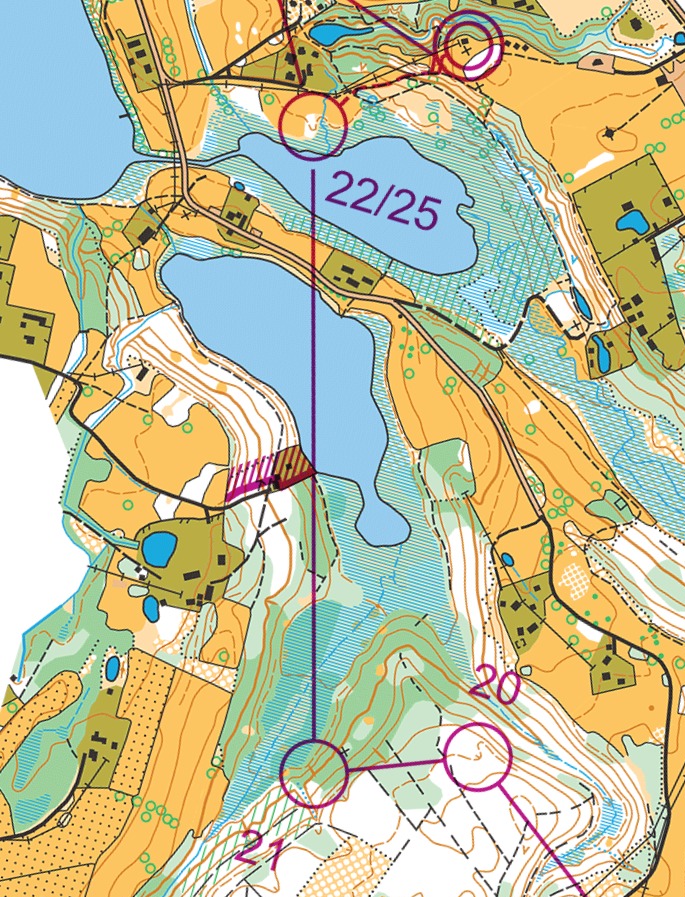
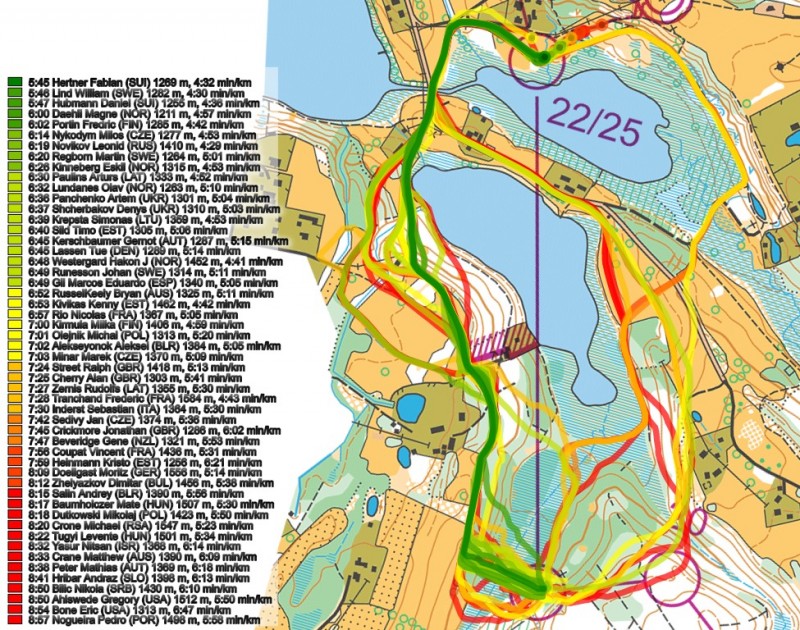
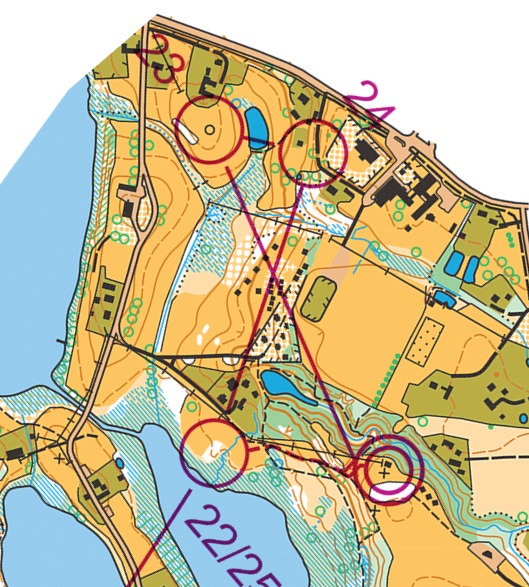
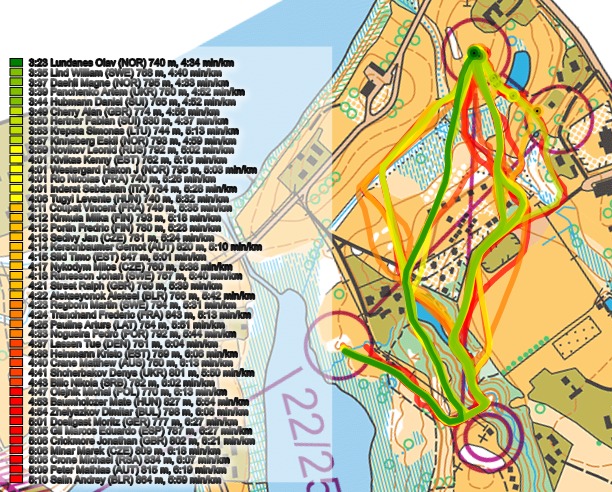
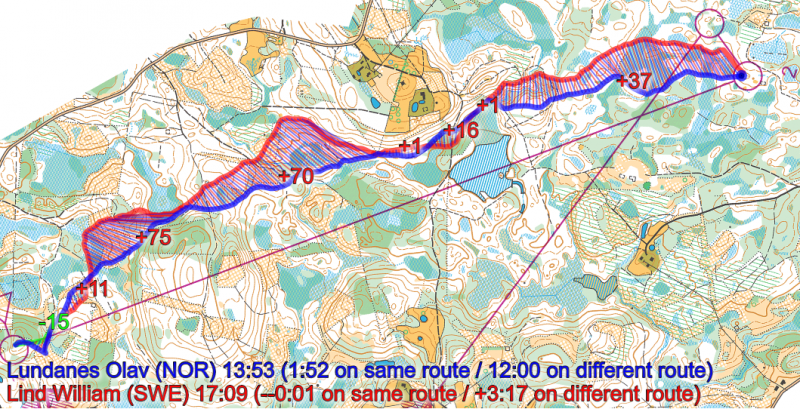
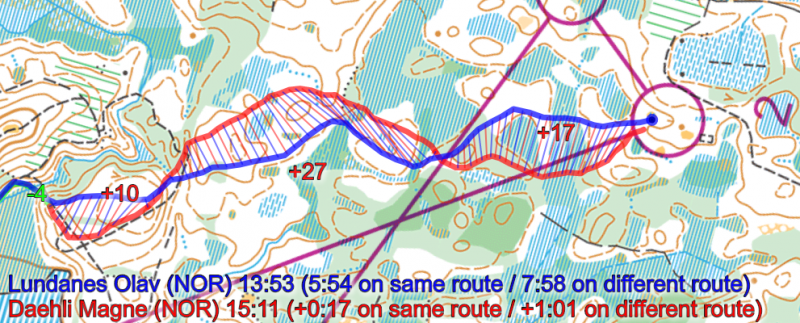
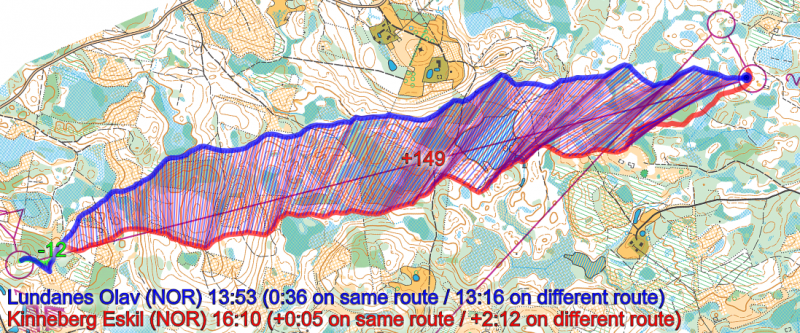
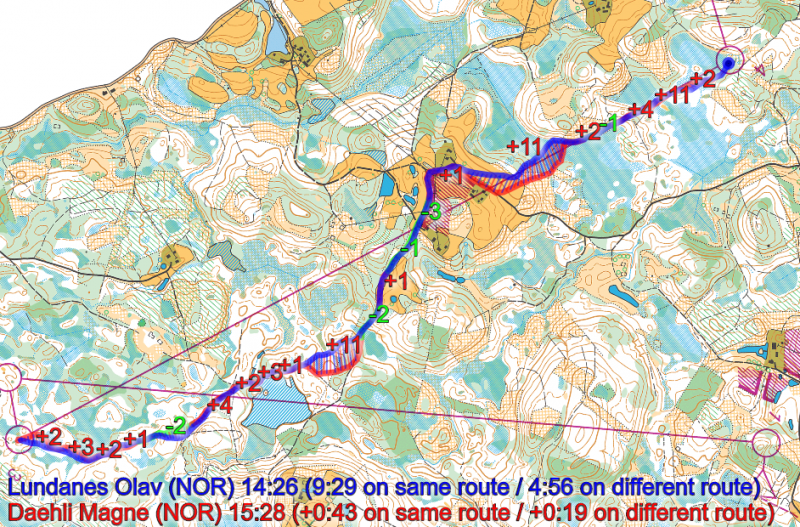
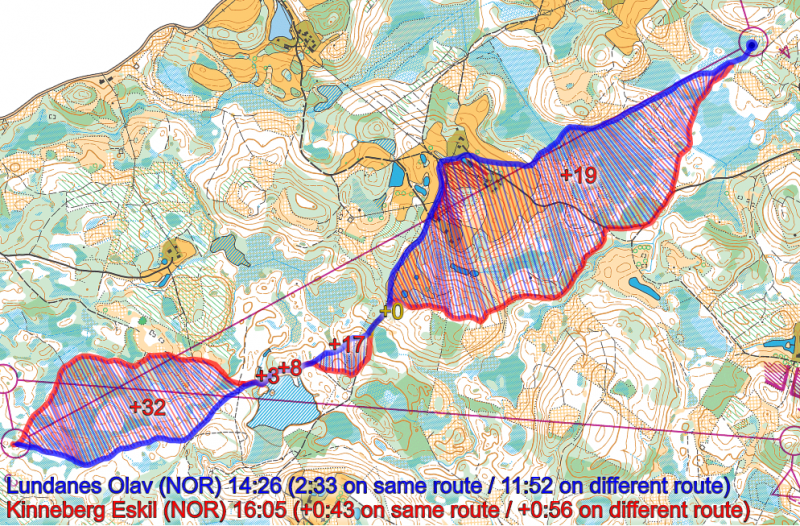
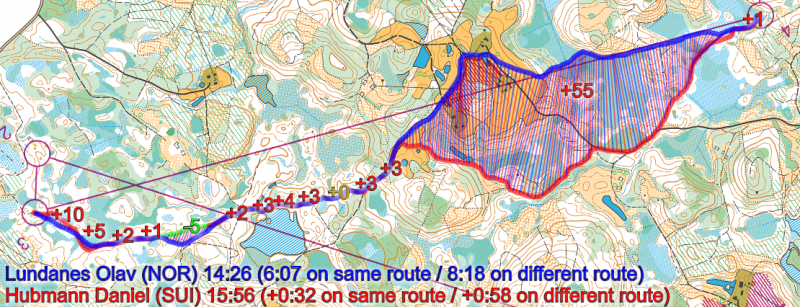

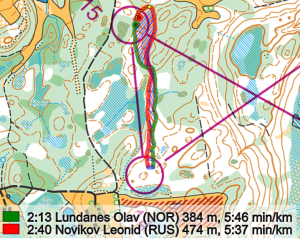
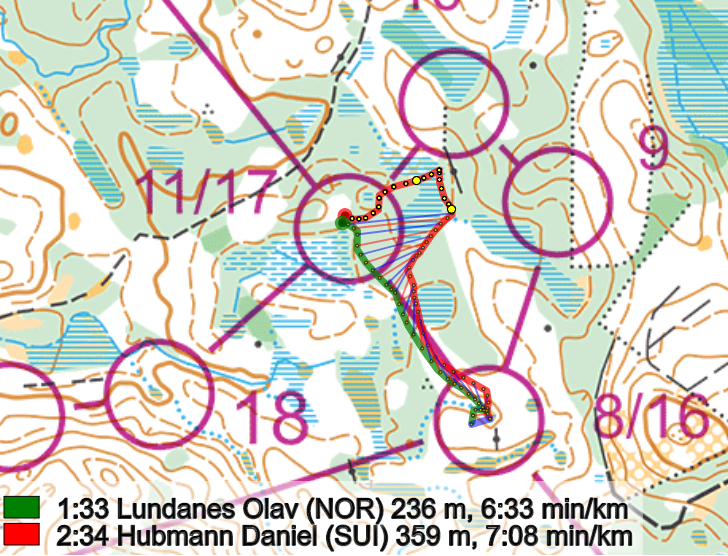



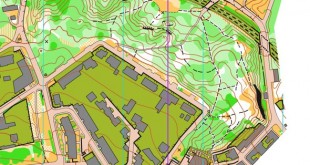
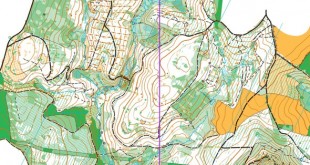
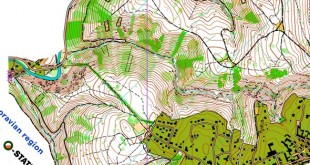
Note that Kyburz was only 30sek slower than Lundanes to the 4th control by doing his really own routechoice to the left. (At least in the beginning)
Thanks, I’ll take a second look at that and add a comment about it!
What about his rout from 2 to 3…?
1 to 2…. Kyburz is as fast as Regborn and Hubman by going right (concluded as ‘significantly slower’ in this article)
Thanks, Trond. I updated the article with a new illustration and a comment. Kyburz is around a minute slower, so I’d still say left is better. But very good to get this into the article as well.
Disclaimer: I am from Baltics and orienteering for 34 years :) …and I have not been in this particular forest.
15-16 and 19-20 straight is optimal and as GPS show faster. Why – see below. I would describe 23-24-25 not as transport, but in fact more of a course setter’s sprint-like trap. If you look closer there are significant variations in climb, distance and runnability for various alternatives. Especially immediately after arena passage on top of the fact that you are tired.
Route to control 2 – Novikov seems to have executed it quite exactly as I describe below. Thus it is a good idea to go straight if you are familiar with this type of terrain to get a better feel of what is to come and get the flow. While it is safer to others to go round. And then there is Timo Sild… who in fact is quite notorius to favor long detours on roads versus terain. :)
By the looks of the map and not been in the forest the southern part of the map is mostly mixed forest while northern part is likely more coniferous. Thus southern part was more fight in general, while northern part more runnable for similar type of colouring.
It is also usual that in this type of terrain that hilltops and gentle slopes are more runnable. You are also advised to use contours/slopes along the marshes as those tend to have animal paths that can be used for faster speed. Unless, of course, the area is green. Avoid clearings as much as you can especially the ones that are not at least light yellow (without pattern). Clearings with green stripes – AVOID, AVOID, AVOID! If you have to, then it is best to use the edge of clearings as they tend to be at places with vegetation boundaries with openings for better running. If a marsh is dark green – avoid it as much as you can even for short stretches. The same goes for streams with steep green banks – avoid unless there is no other option. The same goes for using the streams as navigation; if there is a white hilltop or gentle slope along it – use it, if not – use other navigation features as you are likely going to get stuck in small gullies, bushes and undergrowth along the streams.
If the area is consistently white, then very likely it is with consistently ok runnability, if it is interspersed with green patches, small marshes or vegetation boundaries, then it is likely to be more green than white even if you see a ‘white corridor’ on the map for your route choice.
White with green stripes (especially thick stripes) in the Baltics usually means – AVOID. You are likely to see far ahead, but will fight with undergrowth of sticky raspberries or plenty of undergrowth branches that have been cut recently. If there is light green area next to it, I would use green and not white with stripes.
Marshes with openings – avoid, especially if you are starting ahead of the field. In this time of the year the openings will likely have fairly good visibility, but thick grass up to your nipples. :) On a 200m stretch you can lose up to a minute! If you start at the end – use them with the hope that there are paths made by the ones starting before you. And such marshes will likely have very soft ground that exaggerates the more runners pass any one stretch of it. …and it had been raining heavily recently.
These are general assumptions that you take into account in any Baltic terrain. You adjust as you go, of course.
Thanks for some very nice thoughts about how to solve the challenges in this terrain, Aigars. I’ll put some of it in at the start of the article, I think this is interesting for the readers.
Sure!
…after my previous comment I finally looked through the 2nd part of the article – analysis. It seems that Lundanes and Novikov did exactly that – adjust to the terrain well and use the features to their advantage. While most of the micro route choice errors by others were exactly that – not using enough compass in disperse contour areas and getting stuck in areas where they should not have been in the first place. Only control 21 probably involved more luck than other controls, but still – trust your compass especially on a gentle green slope.